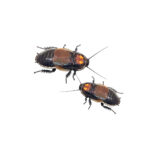

Phyllocrania paradoxa
15,00€
Experience the magic of nature with the Phantom Mantis! Her exceptional camouflage and captivating behavior make her a living treasure. Make it part of your world today! 🌿✨
Sold out
Receive in-stock notifications for this product
Technical sheet of the Phyllocrania paradoxa (Phantom Mantis)
Scientific Name: Phyllocrania paradoxa
Common Name: Ghost mantis
Taxonomic Classification:
Kingdom: Animalia
Phylum: Arthropoda
Class: Insecta
Order: Mantodea
Family: Hymenopodidae
Genus: Phyllocrania
Species: P. paradoxa
Physical Description:
The Phyllocrania paradoxa, also known as the ghost mantis, has an extraordinarily mimetic appearance, perfectly imitating dry or green leaves.
Its body is elongated and flat, with a coloration that varies from brown to green, mimicking the appearance of leaves.
Adults can reach lengths of up to 5 to 7 centimeters.
The forelegs are adapted for capturing prey and resemble miniature leaves, allowing them to camouflage even better in their environment.
Habitat and Distribution:
It is primarily found in tropical Africa and some areas of Madagascar.
It prefers habitats with dense vegetation, such as tropical forests and jungles, where it can easily camouflage among the leaves and wait for its prey.
Behavior and Feeding:
They are carnivorous predators that mainly feed on other insects.
They use their camouflage to stalk their prey, remaining motionless and waiting for them to come close enough to be captured with their adapted forelegs.
They are known for their aggressive behavior during feeding and reproduction.
Life Cycle and Reproduction:
They undergo an incomplete life cycle, with three stages: egg, nymph, and adult.
Females deposit their eggs in oothecae, sac-like structures containing multiple eggs.
Nymphs emerge from the eggs and go through several molts before reaching sexual maturity.
Reproduction usually occurs during the rainy season when environmental conditions are more favorable.
Related products
Dola larvae (pachnoda)
there is stock
Grammostola porteri (Rosea)
there is stock
Brachypelma hamorii (ex smithi)
there is stock
Cubaris panda king
there is stock
there is stock
Pseudoglomeris Magnifica
Sold out
Stick insect (Medauroidea extradentata)
Sold out
Armadillidium vulgare magic potion
there is stock























